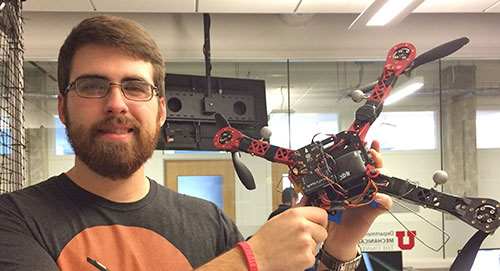
Congratulations to DARC Lab undergraduate researcher Matthew Givens who recently received funding from the University of Utah’s Undergraduate Research Opportunities Program (UROP) to work on project entitled, “Sensorless Obstacle Detection using Ground Effects for Micro Unmanned Aerial Vehicles”. The UROP will provide Matthew with $1200 to support his work with advisor Dr. Kam Leang.
Micro aerial vehicles or MAVs, colloquially referred to as “drones”, are becoming more and more ubiquitous. The applications include aerial photography, precision farming, first response, and search-and-rescue. One of the main challenges of MAVs is detecting nearby objects and terrain features for autonomous flight and collision avoidance. Sensing obstacles and nearby objects for collision avoidance is critically important to autonomous operation. These functions are usually performed by dedicated sensor equipment such as LIDAR, SONAR, and camera-based vision systems. Existing sensing technologies can add weight and complexity to the aerial robot platform, thus decreasing efficiency and endurance. Quadcopters, four-rotor aerial robotic platforms, generate complex aerodynamic flows around the aircraft and when operating near objects and terrain features, exhibit the so called “ground effects”. For decades, helicopter and airplane pilots have noticed a certain effect that the ground has upon the aircraft when they are flying low or landing. The ground effects can drastically impact how the aircraft flies or behaves near objects, walls, or ground surfaces. For example, when a rotor-craft approaches the ground, more lift is generated due to the aerodynamic effects between the aircraft and ground. In this project, ground effects will be exploited to develop a sensorless approach for terrain detection, mapping, as well as autonomous flight and collision avoidance.







